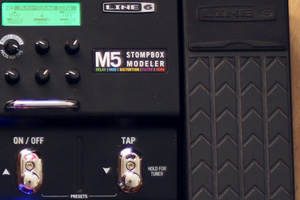
 Sascha
SaschaThe Line 6 M5 – A Cool Universal Pedal
In 2011, Line 6 released the M5; following their M13 and M9 Stompbox modelers. In 2019, with next generation pedals like Line 6’s HX Stomp being around, the M5 is still a relevant pedal – here’s some reasons why. For starters, here’s a vid I made to showcase the options a M5 offers when combined with an expression pedal:
Line 6 Stomp Box Modelers – the History from DL4 to M9
Line 6 started their success story in 1996 with the AxSys 212 digital modelling amp. I saw it in a music store in 1997, A/B’d it against the direct competition, the Johnson Millenium JM150 (which was actually an analog tube/solid state hybrid modelling amp with digital effects), and left the store with the Johnson – it sounded much better to my ears. Until the Helix came out in 2015, none of the Line 6 amp simulations really impressed me.
However, in 1999 Line 6 released the maybe most successful digital pedal so far: The DL4 Delay Modeler. The DL4 is still in production now, 20 years later, in the original version; I’m not aware of any digital pedal with such a long production run. The DL4 was used by countless guitar players from Coldplay’s Jonny Buckland to Radiohead’s Ed O’Brien, from John Mayer to Bill Frisell. The band Minus the Bear famously used four DL4s as loopers. In the following 4 years, Line 6 came up with four more stompbox modelers: The MM4 Modulation Modeler, DM4 Distortion Modeler, FM4 Filter Modeler and AM4 Amplifier Modeler.
In 2008, the M13 was released: A device that could produce all sounds of those stompbox modelers (except the AM4), and then some; including algorithms from the smaller ToneCore pedals such as the Verbzilla. While the previous Stompbox Modelers only had 3 presets, the M13 came with a lot more, and they could be recalled via MIDI. Also, the M13 had 4 engines, so basically, it could be four DL4s – well, it only had one looper, so it couldn’t replace the Minus the Bear “four DL4s as loopers” setup; but pretty much every other combination of the previous Line 6 Stompbox Modelers. Also, it came with a decent tuner on board; and, compared to the DL4, several improvements where implemented:
- The M13 looper adds undo/redo functionality to the DL4 looper’s features. Also, looper time would be doubled from the DL4’s 14 seconds to 28 seconds.
- The DL4 Tape Delay algorithms are also emulating the preamps of the original devices, such as the Echoplex EP-2 and EP-3. Which is understandable, since the Echoplex preamps have a very popular impact on tone, used amongst others by Eddie van Halen; there’s dedicated analog pedals specifically recreating these preamps, such as the Xotic EP booster and the Dunlop Echoplex Preamp. However, the digital emulation in the DL4 was not that great (remember, it was 1997 software), and the dry part of the signal would always run through this emulation in the Tube Delay and Tape Delay models. The M13 improved this by adding “dry thru” versions of those algorithms, which would still digitize the full signal, but would keep the dry part of the signal mostly unaltered.
- DL4 expression pedal implementation has a big flaw when used in conjunction with tap tempo: When tapping in a new tempo, it will always be assigned to only either the heel or the toe position of the expression pedal, depending its position. So after tapping, you will inevitably get tempo glitching when using the expression pedal; which is of course fine if you want tempo glitching, but not if you only want to vary delay mix or repeats with the expression pedal. On the M13, this is fixed.
- Also, the DL4 only allowed tapping in quarter notes, except in one dedicated model – the “Rhythmic Delay”, which would allow 32nd, 16th triplet, 16th, 8th triplet, 8th and quarter triplets (still more than the Strymon Timeline offers). The M13 allowed not less than 19 different subdivisions, useable on all delay models and most modulation models.
In 2009, the M9 followed: Significantly smaller and cheaper than the M13, offering only 3 instead of four engines, but apart from that, mostly identical functionality. Only drawback was that, while the M13 had a display plus a set of 6 knobs for each engine, allowing almost full WYSIWYG (What You See Is What You Get), the M9 only had one display and set of 6 knobs, allowing to modify, and see the settings, for only one of the three engines at a time.
I replaced my DL4 with a M9 in 2009, and I was very happy with the improvements; and to my ears, the M9 can reproduce each DL4 model exactly.
Interlude: Timeline vs. M9
In 2011, I bought the freshly released Strymon Timeline delay to replace my M9. I found it couldn’t – the Timeline dTape algorithm had its own charme, but couldn’t replicate the beloved sound from the DL4 “Tube Echo” model. Here’s a comparison vid I made back in 2012:
Still, though I do like the specific strong filtering of the repeats on the Line 6 Tube Echo algo, I find myself using the Timeline’s dTape algo more and more.
Different story with the Timeline’s “Swell” algo vs. the DL4’s famous “Auto Volume Echo” model, which would also swell the dry part of the signal, while the Timeline would only swell the Echo part: I’ve never used Timeline Swell in any studio or gigging situation, while I use Auto Volume Echo a lot. Combining it with the Timeline on “Ice” gives a great combination. Here’s my Auto Volume vs. Swell comparison vid:
The Swiss Army Knife Pedal
Luckily, at about the same time the M5 came out: Offering all the features of the M9/M13 with a single engine – minus the looper (a perfect companion for the Timeline, and the combo of Timeline + M5 is the two only digital audio pedals that I’ve been running since). Also, it would have 24 presets that could be named – a first for Line 6 Stompbox Modelers.
Since there is only one engine, the M5 has full WYSIWYG again when recalling stored presets, just as the M13 (and other than the M9; or the Timeline). And, other than M9 and M13, it will run from standard 9V center negative power at somewhere around 300 mA, making it very pedal board friendly.
What I like about the M5 is the concept of a “one-at-a-time” multieffect. The M5 offers 100+ different algorithms, but will always just run one at a time (plus an optional noise gate that can be activated per preset; and including some models like the “Echo” reverb which combine two effects in one). So, you are forced to not use pre-programmed effect combinations ... which in my experience leads to more work, but also to a better and more individual sound in the end. Also, other than the much pricier “one-at-a-time” single purpose digital pedals such as Strymon Timeline and Big Sky, the M5 offers delays, reverbs, dirt and compression, filters (including eqs, wahs and guitar synths), modulation and pitch effects.
This makes the M5 the perfect “Swiss Army Knife Pedal” on any non-modeler pedal board: You can get dedicated pedals for all your main sounds that you often use, and have the M5 to add in those special effects that you only rarely need; like, when you need a Whammy sound for one song in one of your bands, but nowhere else, so it doesn’t make sense to you to spend the money (and lose the pedal board real estate) for a real Whammy.
Game of Trons – or: M5 Models Highs and Lows
But don’t be mistaken, the M5 has quite some really good and partly even unique algos of its own: Many people including me love the above mentioned “Auto Volume Echo” model. Also, the guitar-synth-meets-envelope-filter model “Growler” and the granular reverb “Particle Verb” are kinda unique and have many fans. “Frequency Shifter” is an effect you will rarely find elsewhere (showcased at the beginning of the first video in this article).
The Mu-Tron III envelope follower (touch wah) models “Tron Up” and “Tron Down” receive much praise (and you don’t need to pay 700+ € for a 2nd hand Mu-Tron original); “Pattern Tremolo” does a very good job in emulating the much more expensive Lightfoot Labs Goatkeeper pedal. Another very popular model is the “Boost Comp” boost/compressor. “Tube Echo”, “Tape Echo” and “Echo Platter” are still valid and useable digital approximation of the original tape and oil can delays (which are big, expensive and hard to service). “Analog With Modulation” does a decent job of simulating an old EHX Deluxe Memory Man. Of course, in the age of Strymon Volante, Empress Echo System and Source Audio Nemesis, there are better emulations of all these classic delay types out there ... but they will also cost you more.
Other decent M5/M9/M13 models include “Ping Pong” (a quite basic and popular delay type that the Strymon Timeline doesn’t offer ... you need to get a DIG or a Volante for that), “Sweep Echo” (delay with filter), “Bias” and “Opto Tremolo”, “Script Phase” (MXR Phase 90 emulation), “Panned Phaser”, “Analog Flanger” and “Pitch Vibrato” (Boss VB-2 emulation). “Pitch Glide” (useable for anything from adding upper or lower monophonic octaves or 5th up to Whammy pedal stuff, when used with an expression pedal) and “Smart Harmony” (intelligent pitch shifter adding one harmonic voice in a scale and interval of your choice) together can do almost anything a Boss PS-5 or PS-6 will do, and more (like, switching between two different scales and/or intervals with an expression pedal). Also, the EQs, wahs, panner and volume pedal models all are decent and useable.
Less-than-great models include the Leslie / rotary speaker simulations (still, I use “Rotary Drum” live on one song; definitely useable) and the Univibe. Also, the drives are not THAT great. I would never use them as my main drives; but they can come in handy if you need special colours, like an old-school octave-up fuzz; heck, it’s the exact same drive pedal models as in the DM4, which U2’s the Edge has been using for many years in his live rig. So, also definitely useable in a professional context. Finally, the reverbs ... some people really like them. I’m not so convinced (apart from Particle Verb). “Octo” does the job if you occasionally need a Shimmer reverb, but doesn’t come close to Strymon. “Spring Reverb” and “Chamber” both are decent verbs.
Latency
I covered basics of digital latency here. Did some measurements with my M5 recently, and compared it to my brand new HX Stomp. Result: The M5 introduces about 1.2 ms of latency into your signal; this is quite good. Strymon Deco is said to have 0.8 ms, HX Stomp has 1.55 ms.
Here’s screenshots from my Cubase session: Guitar went into an analog splitter, then one half of the signal (upper waveform in the screenshot) went through the M5 to my RME Babyface Pro soundcard, the other half (lower waveform) went directly into the RME.
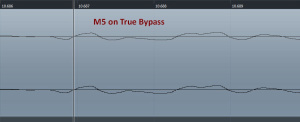
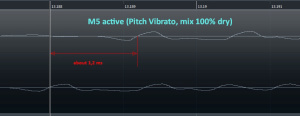
Pricing and Competition
There only two other manufacturers that I know of who offer a similar concept: Hotone with their Xtomp and Xtomp Mini pedals (I didn’t get the chance to play one yet), and Eventide with their H9. Current pricing in Germany would be 109 € for an M5, 129 € for an Xtomp Mini, 199 € for an Xtomp and 649 € for a H9 Max; that would be the version that includes all algorithms (which the M5 always will). There’s also versions with less algos, the H9 Harmonizer (499 €) and the H9 Core (399 €). BTW, neither the M5 nor the Xtomp nor the H9 offer an analog dry path (read more about analog dry paths, and why you may want one, here).
The H9 is something like a high-end M5: With a very similar form factor and approach, but better technology and algorithms. Also, it has a special dual mode: When using the H9 in mono, you can effectively place it in two different places of your signal chain; only one will be active at a time, but you could use it before your drives on one preset, and post-drives on another one. Be aware that this will double the latency, and run your full signal through A/D-D/A conversions twice. The H9 offers without doubt more complex and advanced algos compared to the M5; it can do polyphonic octave pitch shifting, it can add two instead of just one “intelligent” harmony, it has some interesting multi-effect algos like SpaceTime (Delay+Reverb+Modulation) and EQ Compressor.
Does the H9 really sound better than the M5? Most people will say “yes”. Does the H9 sound six times better than the M5, justifying the H9 Max costing almost as much as 6 M5s? Probably not. Can it replicate “Auto Volume Echo”? Nope. Give me my M5 :-)
Combining the M5 with a Boss ES-5 or ES-8 Loop Switcher
In 2017, I bought an ES-5 and build my first pedal board with a programmable loop switcher. I quickly found out that the Boss ES-5 adds a new level to the M5’s functionality (and the ES-8 would do the same; and even more when running a stereo setup). It adresses three of the main shortcomings of the M5:
- M5 only has two footswitches; if you need tap tempo and want to switch presets, you normally need to step on both M5 footswitches to change the switching mode. Also, in one mode you will only see the preset name, and in the other mode only the parameters in the display. The ES-5 makes life easier here: You can call any M5 preset of your choice from the ES-5. So, you can leave the M5 in the mode where the display will show the parameters and preset number (but not name), use the M5 footswitches for bypass and tap functionality, and use the ES-5 for switching M5 presets and showing patch names.
- M5 doesn’t have an analog dry path; and it does mess with the dry signal part in an audible way. Putting the M5 in an ES-5 parallel loop will solve this problem: Set your M5 delays or reverbs to 100% mix, voilà analog dry path. Unfortunately, the M5 doesn’t have a “kill dry” function, that would allow to still mix in the wet portion of the signal. Without this, delays and reverbs will always be at 100% mix level, which will be too loud most of the time. I put a pedal that allows MIDI controlled volume attenuation (either my Sonuus Voluum or my Prostage Remote Wah) behind the M5 inside the same ES-5 parallel path to solve this.
- M5 has only 24 presets. Not much for such a versatile device with 100+ algorithms. With the ES-5, you can get more out of these presets. Like, you can use one M5 delay presets with various tempos, controlled from the ES-5 via MIDI clock. You can put the M5 in a parallel path or not, to use the same octave down preset for either bass simulation (octave down only), or adding a lower octave to a guitar solo (octave down mixed with dry parallel path). You can use the MIDI expression parameter to chose between two different settings of a M5 preset (heel and toe), or any of 126 steps between those two extremes.
The only shortcomings of the M5 that the ES-5 cannot fix would be IMHO:
- rather small display, not bright enough for playing open air gigs;
- no “kill dry” function;
- all M5 algos are 11 to 20 years old – you will not get more modern algos like POG-style polyphonic octaves, and also not the high quality reverbs, univibe and rotary speaker simulation that the newer Line 6 Helix/HX line offers;
- MIDI out jack doesn’t offer MIDI thru functionality;
- limited fidelity / sound quality.
Still, I don’t know any digital pedal that would beat the M5 in bang-for-the-buck ration (maybe the Zoom Multistomps do ... I never played one). So, closing this article, here’s my ES-5 meets M5 video:
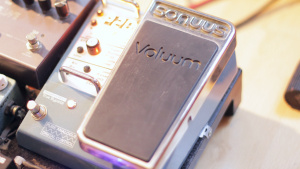
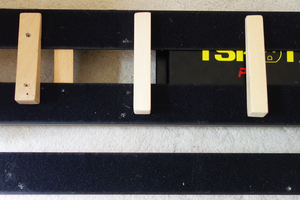
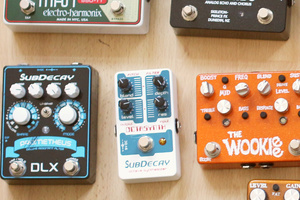
Comments